Early Mythological Paintings by Rubens
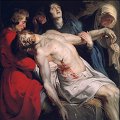 The Flemish and European
Baroque painter Peter Paul Rubens was the
most renowned northern European artist of his day, and is now widely
recognized as one of the foremost painters in Western art history. He
was the proponent of the Baroque style which emphasized
movement, color, and sensuality. By completing
the fusion of the realistic tradition of Flemish painting with the
imaginative freedom and classical themes of Italian Renaissance
painting, he fundamentally revitalized and redirected northern
European painting.
The Flemish and European
Baroque painter Peter Paul Rubens was the
most renowned northern European artist of his day, and is now widely
recognized as one of the foremost painters in Western art history. He
was the proponent of the Baroque style which emphasized
movement, color, and sensuality. By completing
the fusion of the realistic tradition of Flemish painting with the
imaginative freedom and classical themes of Italian Renaissance
painting, he fundamentally revitalized and redirected northern
European painting.
- The Battle of the Amazons (1600)
- Hero and Leander (1605)
- Venus at her Toilet (1608)
- Juno and Argus (1611)
- Prometheus Bound (1611)
- The Drunken Hercules (1611)
- The Abduction of Ganymede (1612)
- Jupiter and Callisto (1613)
- Venus, Cupid, Baccchus and Ceres (1613)
- Venus Frigida (1614)
- The Triumph of Victory (1614)
- Diana Returning from Hunt (1615)
- The Discovery of the Child Erichthonius (1615)
- Romulus and Remus (1616)
- Rape of the Daughters of Leucippus (1617)
- The Drunken Silenus (1617)
The Battle of the Amazons (1600)
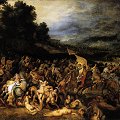 Get
Get  a high-quality picture of
The Battle of the Amazons for your computer or notebook. ‣
After becoming a master in 1678, Rubens also produced paintings in addition to graphic works. His earliest work was very similar in style to that of Van Veen. This is apparent from the rare juvenilia which can on good grounds be ascribed to Rubens, such as the Battle of the Amazons in Potsdam. The classicist portrayal of the characters goes back to Van Veen, but bears witness to a better anatomical insight than is often the case with him.
a high-quality picture of
The Battle of the Amazons for your computer or notebook. ‣
After becoming a master in 1678, Rubens also produced paintings in addition to graphic works. His earliest work was very similar in style to that of Van Veen. This is apparent from the rare juvenilia which can on good grounds be ascribed to Rubens, such as the Battle of the Amazons in Potsdam. The classicist portrayal of the characters goes back to Van Veen, but bears witness to a better anatomical insight than is often the case with him.
The Battle of the Amazons shows small figures in a landscape by Jan Brueghel, here Rubens followed the earlier and specifically Antwerp tradition of sharing out the tasks in landscapes with figures.
Hero and Leander (1605)
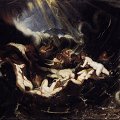 Get
Get  a high-quality picture of
Hero and Leander for your computer or notebook. ‣
The subject of the painting is a legend according to which Leander, a youth of Abydos, a town on the Asian shore of the Hellespont, used to swim across the waters at night to Sestos on the opposite side to meet his lover Hero, a priestess of Aphrodite. She would guide him by holding up a lighted torch. One stormy night Leander was drowned. Hero in despair threw herself into the sea. The story is related in this form by the Greek poet Musaeus (4th-5th century A.D.). Ovid (Heroides, 18, 19) tells of the lovers, omitting their death. The theme is found in Italian and Netherlandish painting, especially of the 17th century which depicts Leander swimming the Hellespont towards a distant tower lighted by Hero; or the drowned Leander is borne away by Nereids as Hero plunges to her death into the sea.
a high-quality picture of
Hero and Leander for your computer or notebook. ‣
The subject of the painting is a legend according to which Leander, a youth of Abydos, a town on the Asian shore of the Hellespont, used to swim across the waters at night to Sestos on the opposite side to meet his lover Hero, a priestess of Aphrodite. She would guide him by holding up a lighted torch. One stormy night Leander was drowned. Hero in despair threw herself into the sea. The story is related in this form by the Greek poet Musaeus (4th-5th century A.D.). Ovid (Heroides, 18, 19) tells of the lovers, omitting their death. The theme is found in Italian and Netherlandish painting, especially of the 17th century which depicts Leander swimming the Hellespont towards a distant tower lighted by Hero; or the drowned Leander is borne away by Nereids as Hero plunges to her death into the sea.
Rubens gives additional intensity to the story by combining consecutive events to produce one highly dramatic scene: the death of Leander, the way his pale, lifeless body is accompanied by thirteen nereids through the churning waves, and finally Hero's plunge into the depth. The subject of Rubens's composition is, in fact, the human body in extremes of movements.
The Hero and Leander was painted during Rubens's second stay at the court of Mantua, where he worked from the middle of 1604 until the end of 1605 for Duke Vincenzo Gonzaga. It belongs to a group of at least five paintings that were evidently painted at this time for the free market, without any definite client. The common feature of these works lies in their portrayal of historical scenes with large number of figures, which allowed Rubens to depict powerfully moving bodies in extreme perspectives. The works show the influence on the young Rubens of Michelangelo and Caravaggio, and also in the particular case of Hero and Leander of Leonardo and Tintoretto.
There is a smaller version of this painting in the Yale University Art Gallery, New Haven.
Venus at her Toilet (1608)
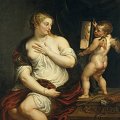 Get
Get  a high-quality picture of
Venus at her Toilet for your computer or notebook. ‣
This painting provides an introduction to Rubens's mythological work and also to his ideal of female beauty. Although it is a copy of an original by Titian, Rubens develops his own characteristic style of splendid and opulent female beauty which has brought his work universal fame. He uses a rich and contrasting palette of light tones, while the looseness of the brushstroke and the bright and uniform lighting serve to soften the contours, giving the painting a feeling of gauzy lightness.
a high-quality picture of
Venus at her Toilet for your computer or notebook. ‣
This painting provides an introduction to Rubens's mythological work and also to his ideal of female beauty. Although it is a copy of an original by Titian, Rubens develops his own characteristic style of splendid and opulent female beauty which has brought his work universal fame. He uses a rich and contrasting palette of light tones, while the looseness of the brushstroke and the bright and uniform lighting serve to soften the contours, giving the painting a feeling of gauzy lightness.
Juno and Argus (1611)
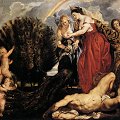 Get
Get  a high-quality picture of
Juno and Argus for your computer or notebook. ‣
Rubens's study of the antique and of the new sciences manifests itself in this huge celebratory work which uses the story of Jupiter's love for Io and the jealousy of his wife Juno as an allegory of the cosmos and demonstrates his colour theory.
a high-quality picture of
Juno and Argus for your computer or notebook. ‣
Rubens's study of the antique and of the new sciences manifests itself in this huge celebratory work which uses the story of Jupiter's love for Io and the jealousy of his wife Juno as an allegory of the cosmos and demonstrates his colour theory.
Rubens's painting represents the concluding scene from the story of Io. The giant Argus of the hundred eyes, whom Juno set to watch over Io, was murdered by Mercury. In memory of Argus Juno took his eyes and set them in the tail of her peacock.
Prometheus Bound (1611)
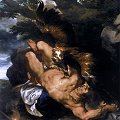 Get
Get  a high-quality picture of
Prometheus Bound for your computer or notebook. ‣
At the height of his glory, Rubens attracted an influx of commissions so great that no one man could possibly satisfy it. Consequently he set about organising a sort of picture factory to meet demand. This was standard practice at the time. When Otto Sperling, the Danish doctor, visited the studio in 1621, he saw "a large hall without windows, lit only by a large skylight. There were many young painters there, working on different canvases, for each of which Rubens had made chalk drawings, here and there adding indications as to colour. These he later finished himself, and they then passed for works by Rubens."
a high-quality picture of
Prometheus Bound for your computer or notebook. ‣
At the height of his glory, Rubens attracted an influx of commissions so great that no one man could possibly satisfy it. Consequently he set about organising a sort of picture factory to meet demand. This was standard practice at the time. When Otto Sperling, the Danish doctor, visited the studio in 1621, he saw "a large hall without windows, lit only by a large skylight. There were many young painters there, working on different canvases, for each of which Rubens had made chalk drawings, here and there adding indications as to colour. These he later finished himself, and they then passed for works by Rubens."
This proceeding has presented art historians with inextricable problems. But Rubens did not mislead his customers: he specified who had worked on what, and adjusted prices to reflect the degree of his own involvement. His collaborators could, in any case, scarcely be described as pupils. He chose them among the best artists of his time, each according to his speciality: one for flowers, another for animals, another again for landscape. They included the landscape artist Jan Wilden and the animal-painters Paul de Vos and Frans Snyders. The Olympian eagle devouring the liver of Rubens' Prometheus Bound was painted by Frans Snyders.
The Drunken Hercules (1611)
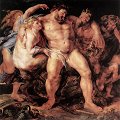 Get
Get  a high-quality picture of
The Drunken Hercules for your computer or notebook. ‣
Rubens decorated the external wall of his studio with several murals in grisaille, which could be interpreted as pictorial reconstructions of famous paintings by such Greek artists as Apelles and Timanthes known only from contemporary written descriptions. It has been established that these grisaille scenes were inspired by the narrative style of classic reliefs. The Drunken Hercules is even a direct adaptation of a now lost Roman relief.
a high-quality picture of
The Drunken Hercules for your computer or notebook. ‣
Rubens decorated the external wall of his studio with several murals in grisaille, which could be interpreted as pictorial reconstructions of famous paintings by such Greek artists as Apelles and Timanthes known only from contemporary written descriptions. It has been established that these grisaille scenes were inspired by the narrative style of classic reliefs. The Drunken Hercules is even a direct adaptation of a now lost Roman relief.
The Abduction of Ganymede (1612)
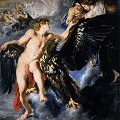 Get
Get  a high-quality picture of
The Abduction of Ganymede for your computer or notebook. ‣
Ganymede was a shepherd, the son of Tros, a legendary king of Troy. His outstanding beauty caused Jupiter to fall in love with him. According to Ovid (Met. 10: 152-161) the god, having transformed himself into an eagle, carried the youth off to Olympus where he made him his cup-bearer. The myth, which is given in a slightly different version by Homer, found favour in ancient Greece because it appeared to provide religious sanction for homosexual love. The representation in Renaissance and later art shows Ganymede caught in the embrace of, or on the back of, the eagle which bears him upwards, its wings either spread in flight or enfolding the youth, its claws holding his limbs. Ganymede may carry a small wine jug in anticipation of his heavenly role. Another version shows his arrival at Olympus where Hebe, the former cup-bearer of the gods, relinquishes her cup to him. A banquet is taking place in the background.
a high-quality picture of
The Abduction of Ganymede for your computer or notebook. ‣
Ganymede was a shepherd, the son of Tros, a legendary king of Troy. His outstanding beauty caused Jupiter to fall in love with him. According to Ovid (Met. 10: 152-161) the god, having transformed himself into an eagle, carried the youth off to Olympus where he made him his cup-bearer. The myth, which is given in a slightly different version by Homer, found favour in ancient Greece because it appeared to provide religious sanction for homosexual love. The representation in Renaissance and later art shows Ganymede caught in the embrace of, or on the back of, the eagle which bears him upwards, its wings either spread in flight or enfolding the youth, its claws holding his limbs. Ganymede may carry a small wine jug in anticipation of his heavenly role. Another version shows his arrival at Olympus where Hebe, the former cup-bearer of the gods, relinquishes her cup to him. A banquet is taking place in the background.
Jupiter and Callisto (1613)
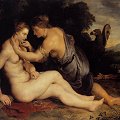 Get
Get  a high-quality picture of
Jupiter and Callisto for your computer or notebook. ‣
The heroic classicist style in the 1610s Which Rubens developed in his religious works was even more apposite in scenes derived from classical themes. Rubens painted many such subjects shortly after 1612. The action in them was carried out by a limited number of figures placed in the foreground and clearly highlighted, giving these paintings an almost relief-like appearance; it may well have been his intention to suggest a comparison with antique relief sculpture.
a high-quality picture of
Jupiter and Callisto for your computer or notebook. ‣
The heroic classicist style in the 1610s Which Rubens developed in his religious works was even more apposite in scenes derived from classical themes. Rubens painted many such subjects shortly after 1612. The action in them was carried out by a limited number of figures placed in the foreground and clearly highlighted, giving these paintings an almost relief-like appearance; it may well have been his intention to suggest a comparison with antique relief sculpture.
The Jupiter and Callisto is one of the many secular subjects Rubens painted in this relief style. The subject of the painting is taken from Ovid. Diana's nymphs were expected to be as chaste as the goddess herself. One of them, Callisto, was seduced by Jupiter who first disguised himself as Diana in order to gain the nymphs presence. Her pregnancy was eventually noticed by Diana who punished Callisto by changing her into a a bear and setting the dogs on her. But Jupiter snatched her up to heaven just in time.
Venus, Cupid, Baccchus and Ceres (1613)
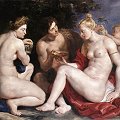 Get
Get  a high-quality picture of
Venus, Cupid, Baccchus and Ceres for your computer or notebook. ‣
Venus and her son Cupid are being offered food and wine by Ceres, goddess of the fruits of the field, and Bacchus, god of wine. The subject comes from a line by the Roman comic poet Terence (d. 159 BC) which frequently figures in the emblem literature that developed from the mid-16th century: 'Sine Cerere et Libero friget Venus' - without Ceres and Bacchus, Venus would freeze. Love is impossible without food and drink. Rather than depicting a boisterous feast, Rubens has opted for a rather restrained scene that must be read as a plea for moderation in pleasure.
a high-quality picture of
Venus, Cupid, Baccchus and Ceres for your computer or notebook. ‣
Venus and her son Cupid are being offered food and wine by Ceres, goddess of the fruits of the field, and Bacchus, god of wine. The subject comes from a line by the Roman comic poet Terence (d. 159 BC) which frequently figures in the emblem literature that developed from the mid-16th century: 'Sine Cerere et Libero friget Venus' - without Ceres and Bacchus, Venus would freeze. Love is impossible without food and drink. Rather than depicting a boisterous feast, Rubens has opted for a rather restrained scene that must be read as a plea for moderation in pleasure.
Rubens produced this painting a few years after his eight-year stay in Italy, where he was employed at the court of Duke Vincenzo Gonzaga of Mantua, and also in Rome. The knowledge of antiquity he gained then was put to use in this painting, as also in a later work on the same theme in 1614, (Royal Fine Arts Museum, Antwerp), Ceres' pose being taken from the Crouching Venus of the Hellenistic sculptor Doidalsas, dating from around 240-230 BC. Rubens certainly knew the marble copy in the Farnese collection in Rome (today in the National Archaeological Museum, Naples).
What he particularly appreciated in Hellenistic and Roman sculpture was its formal dynamism, although he saw in ancient sculpture generally a realm of flawless, ideal nature. In painting from such antique models, he says in his De Imitatione Statuarum, a treatise 'on the imitation of sculpture', the statuary has to be humanised, translated into flesh and blood.
Venus Frigida (1614)
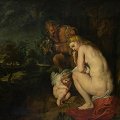 Get
Get  a high-quality picture of
Venus Frigida for your computer or notebook. ‣
The lyricism, eloquence and sensuality that characterise his entire oeuvre are already apparent in Rubens' mythological compositions of 1600-1620. These are often vigorous, earthy works, such as the Venus Frigida. This painting depicts the proverb 'Hunger and thirst cool love's ardour' (Sine cerero et libero friget Venus).
a high-quality picture of
Venus Frigida for your computer or notebook. ‣
The lyricism, eloquence and sensuality that characterise his entire oeuvre are already apparent in Rubens' mythological compositions of 1600-1620. These are often vigorous, earthy works, such as the Venus Frigida. This painting depicts the proverb 'Hunger and thirst cool love's ardour' (Sine cerero et libero friget Venus).
The Triumph of Victory (1614)
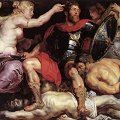 Get
Get  a high-quality picture of
The Triumph of Victory for your computer or notebook. ‣
Rubens painted this moral and political allegory for the Guild of St George, the Antwerp archers' company, in the period of the Eighty Years' War (1568-1648).
a high-quality picture of
The Triumph of Victory for your computer or notebook. ‣
Rubens painted this moral and political allegory for the Guild of St George, the Antwerp archers' company, in the period of the Eighty Years' War (1568-1648).
Rubens, who painted numerous allegories of this sort, shows the victor as a hero in antique armour, bloody sword in hand, seated as if enthroned upon the vanquished figures of Rebellion, symbolised by the torch, and Discord, from whose curls a snake emerges. The goddess of victory crowns him with a wreath of oak leaves. On the right, above the bound figure of Barbarism, a tutelary spirit proffers a a bundle of crossbow bolts, a symbol of concord. On the altar burns the holy flame of the Fatherland, which must be defended. Behind it, red, white and red of the Habsburg flag gives the general, timeless allegory a more specific connection to the time of its composition.
Diana Returning from Hunt (1615)
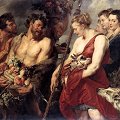 Get
Get  a high-quality picture of
Diana Returning from Hunt for your computer or notebook. ‣
Rubens returned to Antwerp in 1608 from Italy, and he brought with him an interest in the heritage of Antique art and literature that developed into a cornerstone of his thinking and artistic production. After setting up home in Antwerp, he devoted himself with unfailing interest to Greek and Roman mythology, which he used for the subject of many works, mostly as private commissions.
a high-quality picture of
Diana Returning from Hunt for your computer or notebook. ‣
Rubens returned to Antwerp in 1608 from Italy, and he brought with him an interest in the heritage of Antique art and literature that developed into a cornerstone of his thinking and artistic production. After setting up home in Antwerp, he devoted himself with unfailing interest to Greek and Roman mythology, which he used for the subject of many works, mostly as private commissions.
The goddess of Diana was evidently of great importance to Rubens in around 1615, for she could be combined with another subject that interested him: the hunt. Moreover, this subject was well received by his royal and aristocratic patrons: game hunting was the exclusive preserve of the ruling class. Rubens produced a number of large format hunting scenes in 1614-15, many with mythological backdrop.
Rather than emphasizing extremes of movement, as is typical of many of Rubens's hunting pictures, the Diana Returning from Hunt focuses instead on characterizing the powerful, beautiful and pensive huntress. Diana, simultaneously the goddess of chastity, stands with her companions before a group of satyrs, who belong to a quite different branch of Rubens's work: Bacchanalia. Diana's hunting spear divides the different worlds of the two groups And no less different than their appearance and natures are the spoils held by the satyrs on the one side, and Diana and her companions on the other. The fruit presented in richly laden baskets and the intoxicating wine, combined with the lecherous gazes of these half-naked figures, must be seen as an unambiguous sexual overture. Diana, guardian of female chastity, resists. The birds and the dead hare that she and her nymphs have bagged during the hunt reveal them as the conquerors of the pleasurable indulgence embodied by the friends of Bacchus.
The animals and the fruits were painted by Frans Snyders.
The Discovery of the Child Erichthonius (1615)
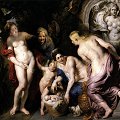 Get
Get  a high-quality picture of
The Discovery of the Child Erichthonius for your computer or notebook. ‣
The story, depicted in the painting is part of the legendary history of Athens and it has echoes of a primitive fertility rite. It tells how Vulcan, in a clumsy attempt to ravish Minerva, accidentally let his semen spill over the ground, and Mother Earth, thus fertilized, gave birth to Erichthonius. Minerva shut the infant in a basket, which she entrusted to the three daughters of Cecrops, king of Attica, forbidding them to open it. But one of them, overcome by curiosity, did so and discovered that the child had a serpent's tail for legs (or that a serpent lay beside it). Maddened with terror the three threw themselves from the top of the Acropolis. Erichthonius, brought up by Minerva, became king of Athens. The three sisters are depicted in the act of opening the basket, out of which a snake uncurls itself. The infant lies inside. Mother Earth is represented by a statue of Diana of Ephesus, the many-breasted goddess of fertility. The theme is most often found in 17th century Netherlandish painting.
a high-quality picture of
The Discovery of the Child Erichthonius for your computer or notebook. ‣
The story, depicted in the painting is part of the legendary history of Athens and it has echoes of a primitive fertility rite. It tells how Vulcan, in a clumsy attempt to ravish Minerva, accidentally let his semen spill over the ground, and Mother Earth, thus fertilized, gave birth to Erichthonius. Minerva shut the infant in a basket, which she entrusted to the three daughters of Cecrops, king of Attica, forbidding them to open it. But one of them, overcome by curiosity, did so and discovered that the child had a serpent's tail for legs (or that a serpent lay beside it). Maddened with terror the three threw themselves from the top of the Acropolis. Erichthonius, brought up by Minerva, became king of Athens. The three sisters are depicted in the act of opening the basket, out of which a snake uncurls itself. The infant lies inside. Mother Earth is represented by a statue of Diana of Ephesus, the many-breasted goddess of fertility. The theme is most often found in 17th century Netherlandish painting.
Romulus and Remus (1616)
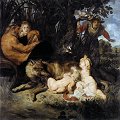 Get
Get  a high-quality picture of
Romulus and Remus for your computer or notebook. ‣
Romulus and his twin brother Remus were the legendary founder of Rome. Their mother, a Vestal Virgin, explained her pregnancy by claiming she had been violated by Mars, the god of war. She was thrown into prison and the children were ordered to be drowned in the Tiber. They survived and were reared by a she-wolf, and by a woodpecker that watched over them and brought them food. The wolf is seen lying under a tree giving suck to an infant, while another plays nearby. The herdsman, Faustulus, who discovered them, is approaching. The god of the River Tiber reclines on his urn. Under the rule of Romulus the city of Rome grew in size and strength.
a high-quality picture of
Romulus and Remus for your computer or notebook. ‣
Romulus and his twin brother Remus were the legendary founder of Rome. Their mother, a Vestal Virgin, explained her pregnancy by claiming she had been violated by Mars, the god of war. She was thrown into prison and the children were ordered to be drowned in the Tiber. They survived and were reared by a she-wolf, and by a woodpecker that watched over them and brought them food. The wolf is seen lying under a tree giving suck to an infant, while another plays nearby. The herdsman, Faustulus, who discovered them, is approaching. The god of the River Tiber reclines on his urn. Under the rule of Romulus the city of Rome grew in size and strength.
Rape of the Daughters of Leucippus (1617)
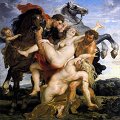 Get
Get  a high-quality picture of
Rape of the Daughters of Leucippus for your computer or notebook. ‣
The lyricism, eloquence and sensuality that characterise his entire oeuvre are already apparent in Rubens' mythological compositions of 1600-1620. These are often vigorous, earthy works, such as the Rape of the Daughters of Leucippus.
a high-quality picture of
Rape of the Daughters of Leucippus for your computer or notebook. ‣
The lyricism, eloquence and sensuality that characterise his entire oeuvre are already apparent in Rubens' mythological compositions of 1600-1620. These are often vigorous, earthy works, such as the Rape of the Daughters of Leucippus.
The two daughters of King Leucippus were betrothed to a set of twins, cousins of Castor and Pollux. But the latter pair carried the maidens off and had sons by them. Armed warriors are seen in the act of seizing the naked maidens and bearing them away on horseback.
The composition of this painting opens upward like the flowering of a bouquet. The two divergent diagonals rise from the base of the painting, where the feet of captive and aggressor are placed side by side. The volumes ascend from this point, harmoniously residing on successive points of equilibrium, while the luminous white forms of the nude victims contrast with the tanned, caparisoned bodies of their hirsute rapists. Here Rubens' classicising and Baroque tendencies are completely reconciled.
The Drunken Silenus (1617)
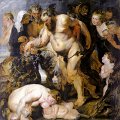 Get
Get  a high-quality picture of
The Drunken Silenus for your computer or notebook. ‣
In Greek mythology Silenus is a rural god, one of the retinue of Bacchus, a gay, fat old drunkard who was yet wise and had the gift of prophecy.
a high-quality picture of
The Drunken Silenus for your computer or notebook. ‣
In Greek mythology Silenus is a rural god, one of the retinue of Bacchus, a gay, fat old drunkard who was yet wise and had the gift of prophecy.
In Rubens' painting he is shown drunkenly tottering, his belly swollen with meat and drink, and supported by a disparate collection of dotards, drunkards, blacks, children and young women. The careless inebriation of this bacchanal is expressed by a thicker touch that conveys the unwieldy weight of the drinkers' gait.
The composition was originally conceived with half-length figures, but was later enlarged by Rubens himself. The painting hung in Rubens' house.
Peter Paul Rubens Art
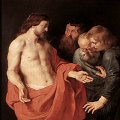
|
|
More
Articles
 Art Encyclopedia A world history of art in articles.
Art Encyclopedia A world history of art in articles.
Baroque
Peter Paul Rubens
Art and life. Biography.
Early mythological paintings.
Late mythological paintings.
Early religious paintings.
Late religious paintings.
Portraits.
Landscapes.
Art
 Art Wallpapers Art image collections for your desktop.
Art Wallpapers Art image collections for your desktop.
Caravaggio Art, $25
(100 pictures)
Rubens Art, $29
(200 pictures)
Rembrandt Art, $25
(160 pictures)

